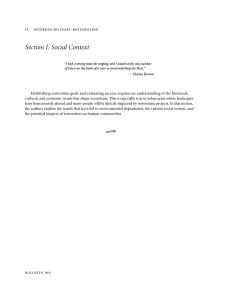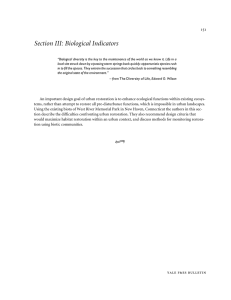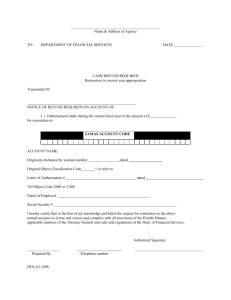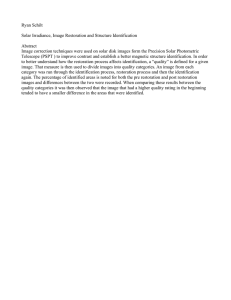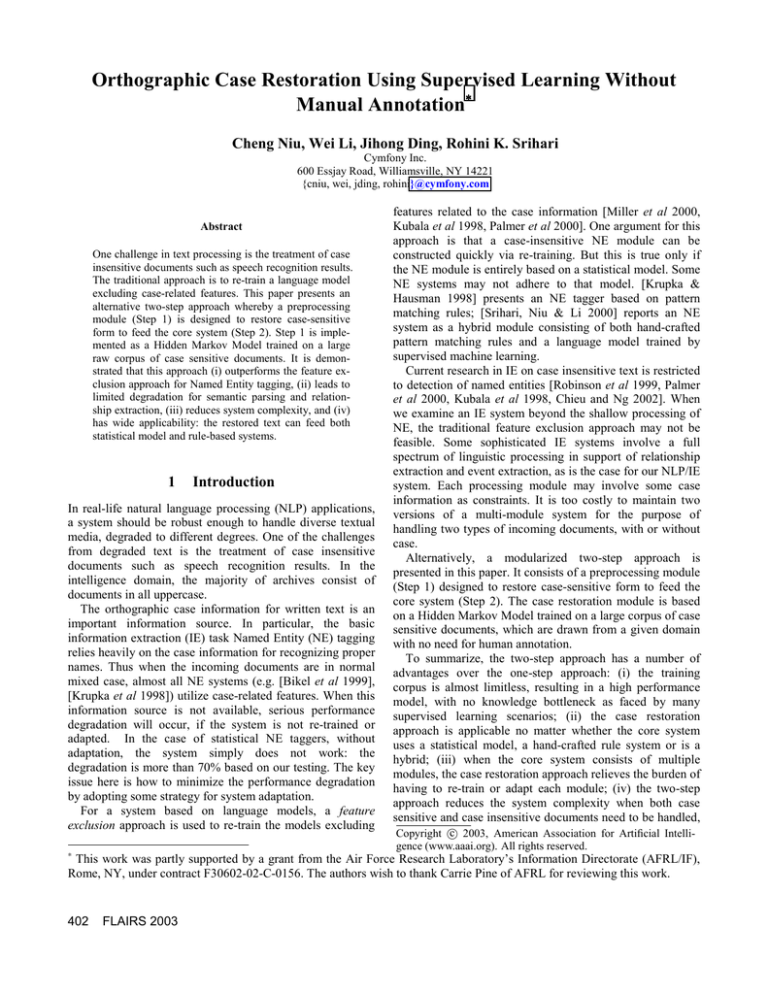
Orthographic Case Restoration Using Supervised Learning Without
Manual Annotation∗
Cheng Niu, Wei Li, Jihong Ding, Rohini K. Srihari
Cymfony Inc.
600 Essjay Road, Williamsville, NY 14221
{cniu, wei, jding, rohini}@cymfony.com
Abstract
One challenge in text processing is the treatment of case
insensitive documents such as speech recognition results.
The traditional approach is to re-train a language model
excluding case-related features. This paper presents an
alternative two-step approach whereby a preprocessing
module (Step 1) is designed to restore case-sensitive
form to feed the core system (Step 2). Step 1 is implemented as a Hidden Markov Model trained on a large
raw corpus of case sensitive documents. It is demonstrated that this approach (i) outperforms the feature exclusion approach for Named Entity tagging, (ii) leads to
limited degradation for semantic parsing and relationship extraction, (iii) reduces system complexity, and (iv)
has wide applicability: the restored text can feed both
statistical model and rule-based systems.
1
Introduction
In real-life natural language processing (NLP) applications,
a system should be robust enough to handle diverse textual
media, degraded to different degrees. One of the challenges
from degraded text is the treatment of case insensitive
documents such as speech recognition results. In the
intelligence domain, the majority of archives consist of
documents in all uppercase.
The orthographic case information for written text is an
important information source. In particular, the basic
information extraction (IE) task Named Entity (NE) tagging
relies heavily on the case information for recognizing proper
names. Thus when the incoming documents are in normal
mixed case, almost all NE systems (e.g. [Bikel et al 1999],
[Krupka et al 1998]) utilize case-related features. When this
information source is not available, serious performance
degradation will occur, if the system is not re-trained or
adapted. In the case of statistical NE taggers, without
adaptation, the system simply does not work: the
degradation is more than 70% based on our testing. The key
issue here is how to minimize the performance degradation
by adopting some strategy for system adaptation.
For a system based on language models, a feature
exclusion approach is used to re-train the models excluding
∗
features related to the case information [Miller et al 2000,
Kubala et al 1998, Palmer et al 2000]. One argument for this
approach is that a case-insensitive NE module can be
constructed quickly via re-training. But this is true only if
the NE module is entirely based on a statistical model. Some
NE systems may not adhere to that model. [Krupka &
Hausman 1998] presents an NE tagger based on pattern
matching rules; [Srihari, Niu & Li 2000] reports an NE
system as a hybrid module consisting of both hand-crafted
pattern matching rules and a language model trained by
supervised machine learning.
Current research in IE on case insensitive text is restricted
to detection of named entities [Robinson et al 1999, Palmer
et al 2000, Kubala et al 1998, Chieu and Ng 2002]. When
we examine an IE system beyond the shallow processing of
NE, the traditional feature exclusion approach may not be
feasible. Some sophisticated IE systems involve a full
spectrum of linguistic processing in support of relationship
extraction and event extraction, as is the case for our NLP/IE
system. Each processing module may involve some case
information as constraints. It is too costly to maintain two
versions of a multi-module system for the purpose of
handling two types of incoming documents, with or without
case.
Alternatively, a modularized two-step approach is
presented in this paper. It consists of a preprocessing module
(Step 1) designed to restore case-sensitive form to feed the
core system (Step 2). The case restoration module is based
on a Hidden Markov Model trained on a large corpus of case
sensitive documents, which are drawn from a given domain
with no need for human annotation.
To summarize, the two-step approach has a number of
advantages over the one-step approach: (i) the training
corpus is almost limitless, resulting in a high performance
model, with no knowledge bottleneck as faced by many
supervised learning scenarios; (ii) the case restoration
approach is applicable no matter whether the core system
uses a statistical model, a hand-crafted rule system or is a
hybrid; (iii) when the core system consists of multiple
modules, the case restoration approach relieves the burden of
having to re-train or adapt each module; (iv) the two-step
approach reduces the system complexity when both case
sensitive and case insensitive documents need to be handled,
c 2003, American Association for Artificial IntelliCopyright °
gence (www.aaai.org). All rights reserved.
This work was partly supported by a grant from the Air Force Research Laboratory’s Information Directorate (AFRL/IF),
Rome, NY, under contract F30602-02-C-0156. The authors wish to thank Carrie Pine of AFRL for reviewing this work.
402
FLAIRS 2003
the system does not need to keep two models for each
module at the same time.
[Gale et al 1992] did a preliminary feasibility study for
case restoration, using some individual examples. But no
substantial research with a large training corpus and fullscale benchmarking has been reported.
The remaining text is structured as follows. Section 2
presents the language model for the case restoration task.
Section 3 shows a series of benchmarks for NE tagging,
relationship extraction and logical Subject-Verb-Object
(SVO) parsing. Section 4 is the conclusion.
2
Implementation of Case Restoration
2.1. Background
The design and implementation of the case restoration module serves as a preprocessing step for a core NLP/IE engine
named InfoXtract, originally designed to handle normal, case
sensitive input.
InfoXtract is a modular, hierarchical NLP/IE system
involving multiple modules in a pipeline structure. Figure 1
shows the overall system architecture involving the major
modules.
Document Processor
Document
pool
Process
Manager
Tokenizer
where and Predefined Event (PE) such as Management
Succession and Product Launch. It is believed that these
information objects capture the key content of the processed
text. The processing results are stored in IE Repository, a
dynamic knowledge warehouse used to support applications.
In order to coordinate with the sophistication of a multilevel NLP/IE system such as InfoXtract, which includes
deep parsing and relationship/event extraction capabilities,
the restoration approach is not just a recommended option, it
is in practice a must. To maintain two versions of such a
sophisticated system for the purpose of handling two types
of documents, with or without case, is too costly and practically impossible.
Figure2 shows the use of Case Restoration as a plug-in
preprocessing module to the core engine. The incoming
documents first go through tokenization. In this process, the
case information is recorded as features for each token. This
token-based case information provides basic evidence for the
procedure called Case Detection to decide whether the Case
Restoration module needs to be called.
Docum ent Input
Linguistic Processor(s)
Tokenization
Source
Document
Lexicon Lookup
Tokenlist
POS Tagging
Tokenlist
IE
Repository
NE
Named Entity
Detection
Output
Manager
CE
Time
Normalization
Location
Normalization
Knowledge Resources
EP
Lexicon
Resources
Semantic
Parsing
SVO
Grammars
Statistical
Models
FST Module
GE
Hybrid
Module
Abbreviations
NE = Named Entity
CE = Correlated Entity
EP = Entity Profile
SVO = Subject-Verb-Object
GE = General Event
PE = Predefined Event
Case Sensitive?
No
Case
Restoration
Module
Yes
Relationship
Detection
Alias/Coreference
Linking
Legend
Procedure or
Statistical Model
Shallow
Parsing
Case Detection
PE
Pragmatic
Filtering
NLP/IE Core Engine
Profile/Event
Merge
Profile/Event
Linking
Figure 1: System Architecture of InfoXtract
InfoXtract involves a full spectrum of linguistic processing
and relationship/event extraction. This engine, in its current
state, involves over 70 levels of processing and 12 major
components. Some components are based on hand-crafted
pattern matching rules in Finite State Transducer (FST)
Modules, some are statistical models or procedures, and
others are hybrid (e.g. NE, Co-reference). The major
information objects extracted by InfoXtract are NE,
Correlated Entity (CE) relationships (e.g. AFFILIATION
and POSITION), Entity Profile (EP) that is a collection of
extracted entity-centric information, SVO which refers to
dependency links between logical subject/object and its verb
governor, General Event (GE) on who did what when and
Output
Figure 2: Case Restoration Interfacing NLP/IE Engine
2.2. Implementation
Case restoration is, by nature, a problem at the lexical level;
syntactic structures seem to be of no particular help. In
[Yarowsky 94], both N-gram context and long distance cooccurrence evidence are used in order to achieve the best
performance in tone restoration. A similar result was predicted for case restoration. But we observe that the majority
of the case restoration phenomena are capturable by local Ngram. We share the observation with [Brill et al 1998] that
the size of a training corpus is often a more important factor
than the complexity of a model for performance enhancement. So a simple bi-gram Hidden Markov Model [Christopher & Hinrich 1999; Bikel et al 1999] is selected as the
proper choice of language model for this task. Currently, the
FLAIRS 2003
403
system is based on a bi-gram model trained on a normal,
case sensitive raw corpus in the chosen domain.
Three orthographic tags are defined in this model: (i) initial uppercase followed by lowercase, (ii) all lowercase, and
(iii) all uppercase.1
To handle words with low frequency, each word is associated with one of five features: (i) PunctuationMark (e.g. &,
?, !…), (ii) LetterDot (e.g. A., J.P., U.S.A.,…), (iii) Number
(e.g. 102,…), (iv) Letters (e.g. GOOD, MICROSOFT, IBM,
…), or (v) Other.
The HMM is formulated as follows. Given a word sequence W = w 0 f 0 w n f n (where f j denotes a single
token feature which will be defined below), the goal for the
case restoration task is to find the optimal tag sequence
T = t 0 t 1 t 2 t n , which maximizes the conditional probability Pr(T | W) [Bikel 1999]. By Bayesian equality, this is
equivalent to maximizing the joint probability Pr(W, T) .
This joint probability can be computed by a bi-gram HMM
as Pr(W, T) =
∏ Pr( w , f
i
i
, t i | w i-1 , f i-1 , t i −1 ) . The back-
i
off model is as follows,
Pr( w i , f i , t i | w i -1 , f i -1 , t i −1 )
words occurring in Part II but not in Part I are all replaced by
a special symbol #Unknown#. Then an HMM for unknown
words is trained on this newly marked corpus. In the stage of
tagging, the unknown word model is used in case a word
beyond the vocabulary occurs.
3
A series of benchmarks in the context of InfoXtract have
been conducted in evaluating the approach presented in this
paper. They indicate that this is a simple but very effective
method to solve the problem of handling case insensitive
input, clearly outperforming the feature exclusion approach.
3.1. Benchmark for Case Restoration
A corpus of 7.6 million words drawn from the general news
domain is used in training case restoration. A separate
testing corpus of 1.2 million words drawn from the same
domain is used for benchmarking. Table 1 shows that the
overall F-measure is 98% (P for Precision, R for Recall and
F for F-measure).
Table 1: Case Restoration Performance
Overall
Lower Case
Non-Lower Case
Initial-Upper Case
All-Upper Case
= λ1 P0 ( w i , f i , t i | w i -1 , f i-1 , t i −1 )
+ (1 - λ1 )Pr( w i , f i | t i , t i −1 )Pr(t i | w i −1 , t i −1 )
Pr( w i , f i | t i , t i −1 )
= λ2 P0 ( w i , f i | t i , t i −1 ) + (1 - λ 2 )Pr( w i , f i | t i )
Pr(t i | w i-1 , t i −1 )
= λ3 P0 (t i | w i-1 , t i −1 ) + (1 - λ3 )Pr(t i | w i-1 )
Pr( w i , f i | t i )
= λ4 P0 ( w i , f i | t i ) + (1 - λ4 ) Pr (w i | t i )P0 (f i | t i )
Pr(t i | w i-1 ) = λ5 P0 (t i | w i-1 ) + (1 - λ5 )P0 ( t i )
1
Pr(w i | t i ) = λ6 P0 (w i | t i ) + (1 - λ 6 )
V
Where V denotes the size of the vocabulary, the back-off
coefficients λ’s are determined using the Witten-Bell
smoothing algorithm, and the quantities
P0 ( w i , f i , t i | w i −1 , f i −1 , t i −1 ) , P0 ( w i , f i | t i , t i −1 ) ,
P0 (t i | w i-1 , t i −1 ) , P0 ( w i , f i | t i ) , P0 (f i | t i ) , P0 (t i | w i-1 ) ,
P0 (t i ) , and P0 (w i | t i ) are computed by the maximum likelihood estimation.
A separate HMM is trained for bigrams involving unknown words. The training corpus is separated into two
parts, the words occurring in Part I but not in Part II and the
The fourth class is mixed case as seen in ‘McDonald’,
‘WordPerfect’, etc. As these phenomena are a minority and
have little impact on performance and benchmarking, they
are excluded from the case restoration training.
404
FLAIRS 2003
P
R
F
0.96
1 0.98
0.97 0.99 0.98
0.93 0.84 0.88
0.87 0.84 0.85
0.77 0.6 0.67
The score that is most important for IE is the F-measure of
recognizing non-lowercase word. We found the majority of
errors involve missing the first word in a sentence due to the
lack of a powerful sentence final punctuation detection
module in the case restoration stage. But it is found that such
‘errors’ have almost no negative effect on the following IE
tasks.2
3.2. Impact of Training Corpus Size
The key for the case restoration approach to work is the
availability of a huge training corpus. It is very fortunate that
for case restoration, the raw text of normal, case sensitive
documents can be used as the training corpus. Such
documents are almost limitless, providing an ideal condition
for training a high performance system.
In general, the larger the training corpus that is used, the
better the resulting model will be [Brill et al 1998]. But in
practice, we often need to make some trade-off between
acceptable performance and available corpus. The corpus
size may be limited by a number of factors, including the
2
1
Benchmark
This type of ‘error’ may have a positive effect on NE. The
normal English orthographic rule that the first word be capitalized can confuse the NE learning system due to the lack of
the usual orthographic distinction between a candidate
proper name and a common word.
limitation of the training time and the computer memory, the
availability of a case sensitive source that suits the domain,
etc. Therefore, it is important to know the growth curve.
Figure 3 shows the impact of the corpus size on the
restoration performance. The study shows that the minimum
size requirement for training a decent case restoration
module is around 2 million words beyond which the
performance increase slows down significantly.
3.3.1. NE Tagging Using Case Restoration
An annotated testing corpus of 177,000 words in the general
news domain is used for the named entity tagging
performance (Table 2), using an automatic scorer following
Message Understanding Conference (MUC) NE standards.
Type
Table 2: NE Degradation Benchmarking 1
Baseline
Case Restored
P
3.3. Degradation Tests
There is no doubt that the lack of case information from the
input text will impact the NLP/IE performance. The goal of
the case restoration module is to minimize this impact. A
series of degradation tests have been run on three basic IE
modules to see how much this impact is and to compare it
with the degradation test reported in the literature.
The experiments and the related degradation benchmarks
reported below are conducted by using the case restoration
module in the context of InfoXtract. We believe that the case
restoration module can work equally well for other NLP or
IE engines, as this is a preprocessing module, with no
dependency on others.
The degradation benchmarking is designed as follows.
We start with a testing corpus drawn from normal case
sensitive text. We then feed that into InfoXtract for
benchmarking. This is normal baseline benchmarking for
case sensitive text input. After that, we artificially remove
the case information by transforming the corpus into a
corpus in all uppercase. The case restoration module is then
plugged in to restore the case before feeding into InfoXtract.
By comparing benchmarking using case restoration with the
baseline, we can calculate the level of performance
degradation from the baseline in handling case insensitive
input for three fundamental capabilities of InfoXtract: NE
tagging, CE relationship extraction, and logical SVO parsing
(which forms the core of general events). In order to have a
direct comparison between the restoration approach and the
traditional feature exclusion approach, the performance of
our re-trained NE model on case insensitive input is also
benchmarked.
F
P
R
F
79.3% 83.0%
81.1%
78.4%
82.1%
80.2%
DATE
91.1% 93.2%
92.2%
91.0%
93.1%
92.0%
MONEY
81.7% 93.0%
87.0%
81.6%
92.7%
86.8%
PERCENT
98.8% 96.8%
97.8%
98.8%
96.8%
97.8%
LOCATION
85.7% 87.8%
86.7%
84.5%
87.7%
86.1%
ORG
89.0% 87.7%
88.3%
84.4%
83.7%
84.1%
PERSON
92.3% 93.1%
92.7%
91.2%
91.5%
91.3%
Overall
89.1% 89.7%
89.4%
86.8%
87.9%
87.3%
2.3%
1.8%
2.1%
Degradation
Figure 3: Impact of Training Corpus Size
R
TIME
The overall F-measure for NE for the case restored corpus is
2.1% less than the performance of the baseline system that
takes the original case sensitive corpus as input.
When the case information is not available, an NE
statistical model has to mainly rely on keyword-based
features, which call for a much larger annotated training
corpus. This is the knowledge bottleneck for all NE systems
adopting the Feature Exclusion approach. In order to
overcome this bottleneck, Chieu and Ng [2002] proposed to
augment the NE training corpus by including machine
tagged case sensitive documents. This approach still requires
NE re-training, but it improves the model due to its
increased training size. It has reported better performance
than some previous feature exclusion efforts, with 3%~4%
performance degradation. However, due to the noise
introduced by the tagging errors, the training corpus can
only be augmented by a small fraction (1/8~1/5) with
positive effect. So the knowledge bottleneck is still there.
3.3.2. NE Tagging Using Feature Exclusion Re-training
The original statistical NE tagger is based on a Maximum
Entropy Markov Model [McCallum et al 2000], trained on
an annotated corpus of 500,000 words in the general news
domain. The NE model is re-trained using the same training
corpus, with the case information removed.
Table 3 shows that the degradation for our re-trained NE
model is 6.3%, a drop of more than four percentage points
when compared with the two-step approach using case
restoration. Since this comparison between two approaches
is based on the same testing corpus using the same system,
the conclusion can be derived that the case restoration
approach is clearly better than the traditional feature
exclusion approach for NE. This is mainly due to the
availability of a huge training corpus from raw text for case
restoration (7,600,000 words in our case) and the limited
human annotated NE training corpus (500,000 words).
FLAIRS 2003
405
Table 3: NE Degradation Benchmarking 2
Type
Baseline
P
R
NE Re-trained
F
P
R
F
TIME
79.3% 83.0%
81.1%
74.5%
74.5%
74.5%
DATE
91.1% 93.2%
92.2%
90.7%
91.4%
91.1%
MONEY
81.7% 93.0%
87.0%
80.5%
92.1%
85.9%
PERCENT
98.8% 96.8%
97.8%
98.8%
96.8%
97.8%
LOCATION
85.7% 87.8%
86.7%
89.6%
84.2%
86.8%
ORG
89.0% 87.7%
88.3%
75.6%
62.8%
68.6%
PERSON
92.3% 93.1%
92.7%
84.2%
87.1%
85.7%
Overall
89.1% 89.7%
89.4%
85.8%
80.7%
83.1%
3.3%
9.0%
6.3%
Degradation
3.3.3. Benchmark on SVO and CE
From an InfoXtract-processed corpus drawn from the news
domain, we randomly pick 250 SVO structural links and 60
AFFILIATION and POSITION relationships for manual
checking (Table 4).
Surprisingly, there is almost no statistically significant
difference in the SVO performance; the degradation due to
the case restoration was only 0.07%. This indicates that
parsing is less subject to the case factor to a degree that the
performance differences between a normal case sensitive
input and a case restored input are not obviously detectable.
The degradation for CE is about 6%. Considering there is
absolutely no adaptation of the CE module, this degradation
is reasonable.
Table 4: SVO/CE Degradation Benchmarking
SVO
CE
Baseline Case Restored Baseline Case Restored
Degradation
CORRECT
196
195
48
43
INCORRECT
13
12
0
1
SPURIOUS
10
10
2
2
MISSING
31
33
10
14
Degradation
PRECISION
89.50% 89.86% -0.36% 96.0% 93.5%
2.5%
RECALL
81.67% 81.25% 0.42%
82.8% 74.1%
8.7%
F-MEASURE 85.41% 85.34% 0.07%
88.9% 82.7%
6.2%
4 Conclusion
In order to properly handle case insensitive text, we have
presented a case restoration approach by using a statistical
model as the preprocessing step for a NLP/IE system. This
solution is benchmarked to clearly outperform the traditional
feature exclusion approaches for the task of Named Entity
tagging:
• for case sensitive input, baseline: 89.4%
• for case insensitive input, using feature exclusion
re-training: 83.1%, degradation: 6.3%
• for case insensitive input, using case restoration:
87.3%, degradation: 2.1%
406
FLAIRS 2003
In addition to NE, the SVO parsing and relationship
extraction are also tested, with very limited degradation. To
our knowledge, this level of NLP/IE has not been
benchmarked in case insensitive text before.
Case Restoration presents a rare scenario where
supervised learning can be performed with no knowledge
bottleneck. A simple statistical bigram technique has been
shown to yield very good results.
References
Bikel, D.M., R. Schwartz, R.M. Weischedel. 1999. An
Algorithm that Learns What’s in a Name. Machine
Learning, Vol. 1,3, pp. 211-231.
Brill, E., and et al 1998. Beyond N-Grams: Can Linguistic
Sophistication Improve Langauge Modeling? ACL-1998
Chieu, H.L. and H.T. Ng. 2002. Teaching a Weaker Classifier: Named Entity Recognition on Upper Case Text.
Proceedings of ACL-2002, Philadelphia.
Christopher, D.M. and S. Hinrich. 1999. Foundations of
Statistical Natural Language Processing, the MIT press.
Gale, W., K. Church, and D. Yarowsky. 1992. Discrimination Decisions for 100,000-Dimensional Spaces. Statistical Research Reports, No. 103, Jan 16, 1992, AT&T
Bell Laboratories
Krupka, G.R. and K. Hausman. 1998. IsoQuest Inc.:
Description of the NetOwl (TM) Extractor System as
Used for MUC-7, Proceedings of MUC-7
Kubala, F., R. Schwartz, R. Stone and R. Weischedel. 1998.
Named Entity Extraction from Speech. Proceedings of
DARPA
Broadcast
News
Transcription
and
Understanding Workshop.
McCallum, A., D. Freitag, and F. Pereira. 2000. Maximum
Entropy Markov Models for Information Extraction and
Segmentation. Proceedings of 17th International
Conference on Machine Learning
Miller, D., S. Boisen, R. Schwartz, R. Stone, and R.
Weischedel. Named Entity Extraction from Noisy Input:
Speech and OCR. Proceedings of ANLP 2000, Seattle
Palmer, D., M. Ostendorf, J.D. Burger. 2000. Robust
Information Extraction from Automatically Generated
Speech Transcriptions. Speech Communications, Vol.
32, pp. 95-109.
Robinson, P., E. Brown, J. Burger, N. Chinchor, A. Douthat,
L. Ferro, and L. Hirschman. 1999.
Overview:
Information Extraction from Broadcast News.
Proceedings of The DARPA Broadcast News Workshop
Herndon, Virginia.
Srihari, R., C. Niu, & W. Li. 2000. A Hybrid Approach for
Named Entity and Sub-Type Tagging. Proceedings of
ANLP 2000, Seattle.
Yarowsky, D. 1994. A Comparison Of Corpus-Based
Techniques For Restoring Accents In Spanish And
French Text. 2nd Workshop on Very Large Corpora,
p319-324.

